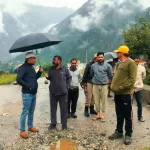Nestled between majestic mountain ranges, the Kashmir Valley unveils a distinctive winter landscape that commences its icy grip with the advent of October. This seasonal transition prompts a strategic adaptation among its residents, who face the unforgiving cold by blending age-old practices with modern innovations, creating a harmonious coexistence between tradition and progress.
An enduring symbol of winter resilience in Kashmir is the traditional “Kangri,” a portable earthenware pot filled with hot embers, a practice embraced by locals for generations. This humble yet effective heating method stands as a testament to the resourcefulness of the Kashmiri people in navigating the challenges posed by the harsh winter chill. However, the passage of time has seen the emergence of modern heating appliances that now stand alongside the Kangri, forming a symbiotic relationship that represents the fusion of tradition and technology in the battle against the bitter cold.
This coexistence of traditional and modern heating methods underscores the dynamic nature of Kashmiri society. It is a society where age-old practices seamlessly integrate with contemporary solutions, demonstrating an adaptive spirit that enables the residents to thrive in the face of changing times.
In both mosques and homes, another cornerstone in the fight against winter’s cold embrace is the “Hamam,” a traditional bathhouse that has stood as a beacon of warmth for centuries. The Hamam is not merely a functional space but a sanctuary where individuals seek solace from the freezing winds and heavy snowfall that characterize Kashmir’s winter. In these communal spaces, a sense of shared warmth fosters a deeper connection among individuals, emphasizing the importance of community in the face of adversity.
Within the realm of religious practices, the Hamam plays a unique role in mosques. It ensures that devout individuals, engaged in the ritual of praying five times a day, are shielded from the shock of cold water. This consideration for the comfort of worshippers reveals the integral role that cultural practices play in shaping the everyday lives of Kashmiris, emphasizing the seamless integration of tradition into their religious devotion.
A crucial aspect of maintaining the functionality of the Hamam involves the daily ritual of collecting wood. From dawn until dusk, this laborious task ensures a steady supply of fuel to keep the Hamam adequately heated. The commitment to this routine underscores the importance placed on ensuring a comfortable and consistent heating process, embodying the resilience ingrained in the Kashmiri way of life.
Beyond its primary function of providing warmth to the body, the Hamam also serves to maintain warm water. In a land where the cold permeates every aspect of daily existence, the availability of warm water becomes a crucial comfort. This dual functionality enhances the Hamam’s significance as a cornerstone of winter survival in Kashmir, reflecting its multifaceted role in addressing the diverse challenges posed by the harsh climate.
The endurance of the tradition of using baths in the valley for centuries is a testament to its cultural and practical significance. It represents more than just a means of staying warm; it encapsulates a connection to the land, a shared history, and a communal resilience that has withstood the test of time. This enduring tradition reflects the deep-rooted cultural identity of the Kashmiri people, highlighting their ability to draw strength from age-old practices that have shaped their collective experience.
While wood-fired Hamams continue to hold sway as a symbol of tradition, the march of progress has ushered in modernity even in the realm of heating practices. Electric Hamams have found a place in contemporary homes, marking a departure from purely traditional methods and embracing the convenience offered by technological advancements. This amalgamation of the old and the new illustrates the adaptive spirit of the Kashmiri people, who navigate the delicate balance between preserving heritage and embracing progress.
The winter experience in the Kashmir Valley is woven with threads of tradition and adaptation. From the humble Kangri to the enduring Hamam, the practices employed to combat the bitter cold reflect a nuanced approach that honors the past while embracing the present. As the valley continues to evolve, so too will its methods of staying warm, but the essence of enduring winters with a sense of community and shared warmth will remain a timeless aspect of Kashmiri life. The resilience and adaptability of the Kashmiri people in the face of winter’s challenges are etched into the very fabric of their cultural identity, creating a narrative that transcends generations.





